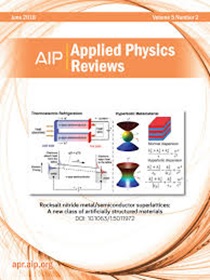超高频、宽频带和小型化声波滤波器的进展和未来展望
IF 11.6
1区 物理与天体物理
Q1 PHYSICS, APPLIED
引用次数: 0
摘要
在新的通信标准和广泛应用的急剧扩展的推动下,用于通信的射频滤波器得到了迅速发展。尽管它们目前在移动通信、空对地通信和物联网等应用中发挥着至关重要的作用,但要快速成功地应用,它们的要求非常严格和具有挑战性。与传统的低温共烧陶瓷、集成无源器件滤波器和介电滤波器相比,声波滤波器具有带宽宽、体积小、插入损耗低的优势,被认为是具有竞争力的选择。本文回顾了用于射频通信的高频声波器件的进展并概述了未来的前景,重点关注几个关键问题,包括带宽、滚转、频率、功率处理、插入损耗、带外抑制、可调性和尺寸/封装。主要关注射频声波滤波器的极限性能突破,如如何实现工作频率在8ghz以上、带宽在1ghz左右、品质因数超过2000的声学器件。讨论了实现超高频射频滤波器优越性能的各种原理、策略和技术,例如,应用先进材料,如掺钪AlN或AlN和LiNbO3的单晶,创建新的拓扑结构,如混合滤波器,以及产生新型声波振动模式。本文章由计算机程序翻译,如有差异,请以英文原文为准。
Advances and future perspectives for super-high frequency, wide-band, and miniaturized acoustic wave filters
Radio frequency (RF) filters for communication have been developed rapidly, driven by new communication standards and the dramatic expansion of wide-range applications. Although they are currently playing crucial roles in applications such as mobile communication, space-to-ground communication, and the Internet of Thing, there are significantly stringent and challenging requirements demanded for their rapid and successful applications. Compared with conventionally adopted low-temperature co-fired ceramics, integrated passive device filters, and dielectric filters, acoustic wave filters have been regarded as the competitive choice, mainly attributed to their wide bandwidth, small size, and low insertion loss. This paper reviews the advances and outlines future perspectives of high frequency acoustic wave devices for RF communication, focusing on several critical issues including bandwidth, roll-off, frequency, power-handling, insertion loss, out-of-band rejection, tunability, and size/package. It is focused mainly on the extreme performance breakthroughs of RF acoustic wave filter, e.g., how to achieve acoustic devices with operating frequency above 8 GHz, bandwidth around 1 GHz, and quality factor exceeding 2000. Various principles, strategies, and technologies for achieving the superior performance of super-high frequency RF filters are discussed, e.g., applying advanced materials such as scandium-doped AlN or single crystals of AlN and LiNbO3, creating new topology structures such as hybrid filters, and generating new types of vibration modes of acoustic waves.
求助全文
通过发布文献求助,成功后即可免费获取论文全文。
去求助
来源期刊

Applied physics reviews
PHYSICS, APPLIED-
CiteScore
22.50
自引率
2.00%
发文量
113
审稿时长
2 months
期刊介绍:
Applied Physics Reviews (APR) is a journal featuring articles on critical topics in experimental or theoretical research in applied physics and applications of physics to other scientific and engineering branches. The publication includes two main types of articles:
Original Research: These articles report on high-quality, novel research studies that are of significant interest to the applied physics community.
Reviews: Review articles in APR can either be authoritative and comprehensive assessments of established areas of applied physics or short, timely reviews of recent advances in established fields or emerging areas of applied physics.
 求助内容:
求助内容: 应助结果提醒方式:
应助结果提醒方式:


